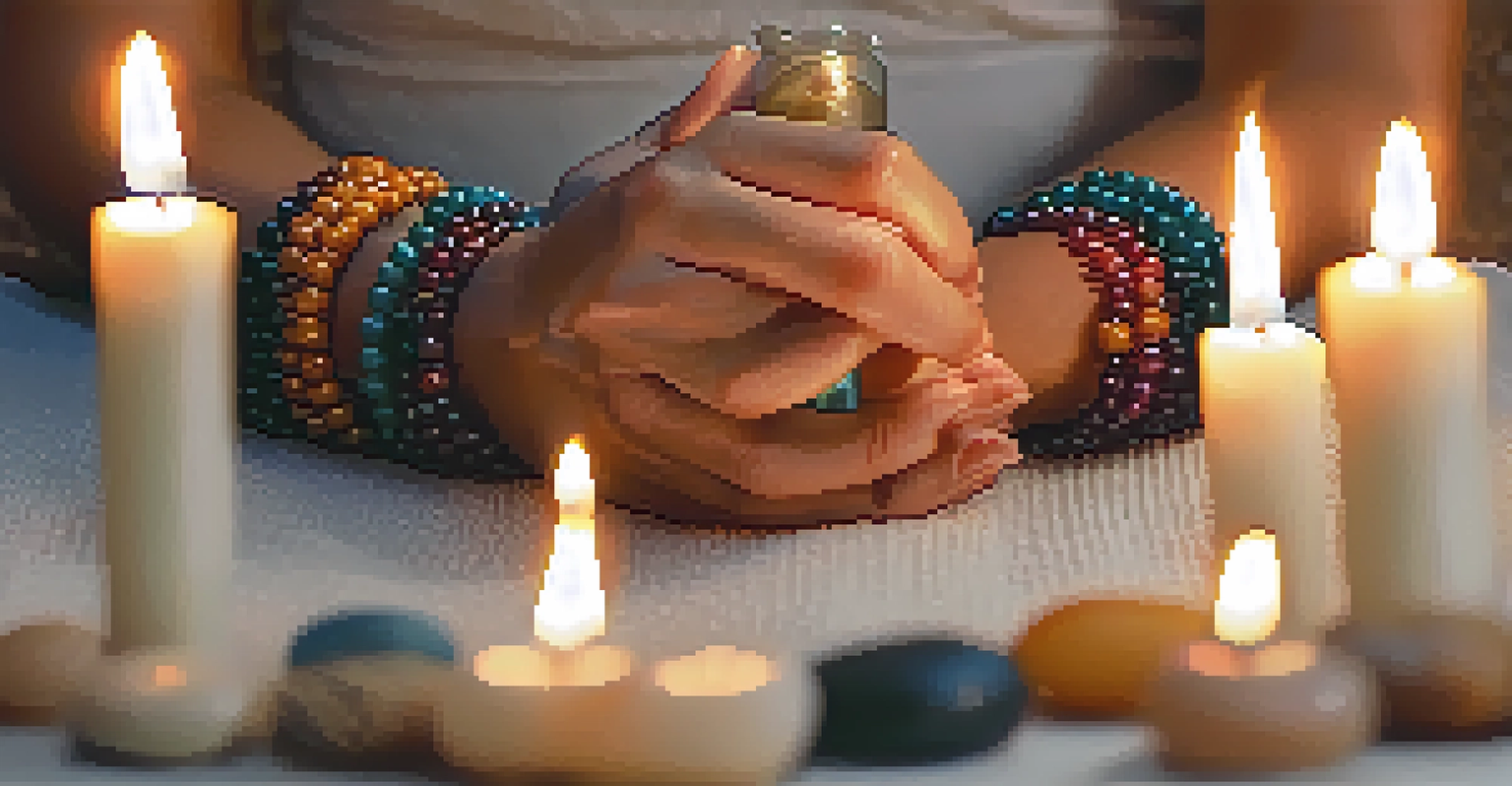The Role of Rituals in Yoga: Cultural Significance Revealed

Understanding the Essence of Rituals in Yoga
Rituals in yoga serve as frameworks that guide practitioners in their spiritual journey. They provide structure and intention, allowing individuals to connect more deeply with their practice. With roots in ancient traditions, these rituals help maintain the integrity of yoga as it evolves over time.
Yoga is the journey of the self, through the self, to the self.
When we think of rituals, we often envision repetitive actions filled with meaning. In yoga, this could be as simple as the way we set up our mats or the breathing exercises we perform. Each of these actions is imbued with purpose, creating a sacred space for reflection and mindfulness.
Moreover, rituals foster a sense of community among practitioners. Whether in a group class or solo practice, the shared experience of rituals can create bonds and enhance the collective energy, making each session feel more profound and connected.
The Historical Roots of Yoga Rituals
The origins of yoga can be traced back thousands of years, steeped in rich cultural traditions. Early yogis incorporated rituals into their practices as a means to connect with the divine and understand their place in the universe. These rituals often included offerings, chants, and meditative practices that elevated their spiritual experience.

As yoga spread across different cultures, it absorbed various local customs and beliefs, further enriching its ritualistic aspects. For instance, the incorporation of mantras and specific postures into rituals reflects the diverse philosophies that have influenced yoga. This blending of traditions showcases the adaptability and resilience of yoga throughout history.
Rituals Enhance Yoga Practice
Rituals provide structure and intention, deepening the connection practitioners have with their yoga journey.
Understanding these historical rituals adds layers of meaning to contemporary practices. By acknowledging the past, modern practitioners can appreciate the depth and significance behind their movements, transforming their yoga from mere exercise into a holistic experience.
Rituals as a Path to Mindfulness
In our fast-paced lives, rituals provide a much-needed pause, inviting us to slow down and be present. This mindfulness is a core component of yoga, allowing practitioners to engage fully with their breath and body. Rituals act as gentle reminders to cultivate awareness in our movements and thoughts.
The breath is the bridge which connects life to consciousness, which unites your body to your thoughts.
For example, the simple act of lighting a candle before practice can signify a transition from the chaos of daily life to a space of serenity. Such rituals prompt us to reflect and set intentions, enhancing our overall yoga experience. This intentionality fosters a deeper connection to the self, promoting healing and self-discovery.
By integrating rituals into our practice, we create a sanctuary for ourselves. This sacred space encourages us to explore our inner landscape, facilitating personal growth and emotional well-being.
The Role of Breath in Yogic Rituals
Breath is often referred to as the bridge connecting the body and mind, playing a crucial role in yoga rituals. Known as 'pranayama,' breath control is a practice that cultivates energy and focus. Each inhalation and exhalation can be seen as a ritual in itself, grounding us in the present moment.
Incorporating specific breathing techniques into rituals enhances their effectiveness. For instance, starting a session with deep, conscious breaths prepares the mind and body for the practice ahead. This mindful breathing creates a rhythm that anchors us, allowing for a more profound engagement with our movements.
Breath as a Central Element
Breath control, or pranayama, serves as a pivotal ritual in yoga, anchoring practitioners in the present and facilitating emotional release.
Moreover, breath serves as a tool for emotional release during practice. By consciously attuning to our breath, we can navigate through feelings of tension or stress, transforming our rituals into powerful vehicles for release and renewal.
Symbolic Items in Yoga Rituals
Many yoga rituals incorporate symbolic items that carry deep meanings, enriching the practice. For example, the use of mala beads during meditation serves as a tactile reminder of intention and focus. Each bead can represent a mantra or a quality we wish to cultivate, making the ritual more interactive.
Other items, like candles or incense, create a sensory experience that enhances the sacred atmosphere. The flickering flame or soothing scent can evoke feelings of peace and connection, inviting practitioners to immerse themselves fully in the ritual. These symbols help ground the practice, making it more relatable and meaningful.
By integrating these items into our rituals, we invite layers of significance into our practice. Each object serves as a focal point, guiding us through our journey while reminding us of the deeper meanings behind our movements and intentions.
Rituals as a Means of Personal Transformation
Ultimately, rituals in yoga can be catalysts for personal transformation. Engaging in these practices consistently allows individuals to reflect on their growth and experiences. Each ritual becomes a stepping stone on the path to self-discovery, offering insights that can lead to profound changes in one's life.
For instance, dedicating a specific time each day to practice a particular ritual can cultivate discipline and commitment. Over time, this dedication often translates into other areas of life, fostering resilience and a sense of purpose. The changes may be subtle at first, but they can accumulate, leading to significant shifts in perspective and behavior.
Rituals Foster Personal Growth
Consistently engaging in yoga rituals can lead to personal transformation, discipline, and a greater sense of self-awareness.
As practitioners embrace these rituals, they often find themselves more attuned to their inner voice and intuition. This heightened awareness serves as a guiding light, empowering individuals to navigate life's challenges with grace and confidence.
The Future of Rituals in Modern Yoga
As yoga continues to evolve in the modern world, the role of rituals remains as relevant as ever. While some practitioners may gravitate towards more contemporary interpretations, the essence of rituals still holds immense value. The challenge lies in finding a balance between tradition and innovation in today's fast-paced society.
Many modern yoga studios are now incorporating elements of traditional rituals into their classes, creating a fusion that resonates with diverse audiences. This blend honors the roots of yoga while making it accessible and relatable to a wider range of practitioners. The future of yoga rituals is about inclusivity and adaptability.

By embracing both the old and new, we can foster a richer and more diverse yoga community. As we navigate this evolving landscape, the essence of rituals will continue to guide us, reminding us of the importance of mindfulness, connection, and personal growth in our practice.